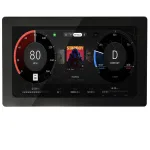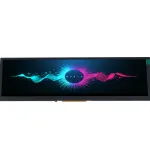Views: 2 views
A Surprising Panel Industry Start to the Year
While happily celebrating the Chinese New Year, I came across surprising news: Trump had just announced new tariffs on Chinese goods. The announcement made me feel that the future of global trade might become more uncertain.
Back to the main topic. Here’s some notable news from the Chinese display industry after the Spring Festival.
P.S. Wishing everyone a Happy New Year!
Policy Stimulus Powers Upstream Recovery
A wave of trade-in programs and consumption-stimulating policies is fueling the recovery of China’s consumer electronics sector. This momentum is also lifting the upstream panel industry. In early 2024, panel makers adopted tighter production control and pricing strategies. These steps helped stabilize prices and led to strong financial performance across the industry.
Many panel manufacturers released positive earnings forecasts for 2024. According to Wind data, 10 A-share panel companies shared their projections. These include BOE Technology Group (BOE A), Shenzhen Zhongheng Huafa, Suzhou Tianlu Optical (Tianlu Technology), and Oriental Optronics. Six of them expect significant improvements in business performance.
BOE A and Tianlu Lead the Comeback
On January 20, BOE A projected a net profit of RMB 5.2 to 5.5 billion in 2024. This represents a year-on-year growth of 104 to 116 percent.
BOE A attributed this growth to several key factors. In the LCD segment, manufacturers followed demand-driven production strategies. At the same time, trade-in programs and new applications helped drive strong demand, especially in TV displays, which saw remarkable growth. The domestic market is expected to rebound in the second half of 2024, with large-sized panel shipments reaching new highs. Overseas markets also performed well. Global sports events and promotional campaigns contributed to higher prices.
In flexible AMOLED, BOE A anticipates shipping around 140 million units this year. The company improved its product mix by increasing the share of high-end displays. It also expanded into innovative mid-sized applications such as automotive and IT displays. These moves strengthened its product capabilities and overall competitiveness in the flexible AMOLED segment.
Tianlu Technology also expects strong growth. The company projects a net profit of RMB 24 to 30 million, reflecting a year-on-year increase of 171 to 239 percent. Tianlu linked this growth to a rebound in light guide plate shipments, driven by the recovery of the downstream panel industry. The company also promoted high-margin products more aggressively, which improved profitability.
Experts Confirm Momentum and Market Demand
Cui Jilong, General Manager of Beijing Display Information Consulting, told Securities Daily that subsidy policies have helped the panel industry gain momentum since the start of the year.
A report from TrendForce Consulting noted that TV panel prices rose in January. Prices for 32- and 43-inch panels increased by 1 US dollar per unit. The price of 55-inch panels rose by 1 dollar, 65-inch panels by 2 dollars, 75-inch panels by 3 dollars, and 85-inch panels by 4 dollars. These increases reflect strong demand for large-format panels.
Xue Xiuyuan, Board Secretary of Beijing Bayi Space LCD, commented in an interview that demand from downstream customers has clearly improved. He also mentioned that national subsidies encouraged early stocking by brands. He added that 2025 presents a great opportunity, and the company is actively expanding into new markets to capture more share.
Trade Tensions and Industry Growth: Opportunities and Risks for Global Brands
Short-Term Demand Creates Opportunities and Risks
From my perspective, the current panel industry recovery offers cautious optimism for customers.
In the short term, government policies such as trade-in subsidies and global sports events are driving demand. Large-sized panels have shown strong pricing power. For instance, 75-inch panels rose by 3 dollars, which signals solid demand in the high-end market.
For global brands, this trend creates both opportunities and challenges. On one hand, rising prices may lead to better profit margins. On the other hand, they could increase the cost of end products and possibly reduce consumer demand.
Chinese panel makers are managing supply more tightly while trying to stabilize prices. This benefits overall industry health but could also create short-term supply constraints. Buyers may face delivery pressure or price fluctuations during peak sales seasons such as Black Friday.
BOE’s AMOLED Strategy and Global Supply Shifts
BOE’s rapid expansion in flexible AMOLED, which is expected to reach 140 million units annually, positions the company as a strong competitor to Samsung and LG. This is especially true in automotive and IT display segments. For global buyers, this provides an alternative supply source. However, quality consistency and intellectual property risks must be carefully evaluated.
Looking further ahead, challenges remain. The current growth relies heavily on government policy. If subsidies are reduced or global economic conditions weaken, demand may become difficult to sustain.
Geopolitical tensions also continue to pose risks. As a strategic industry, the panel sector could be affected by ongoing U.S.-China trade friction. For example, the United States imposed additional tariffs on Chinese panels starting February 4. In response, some companies have begun diversifying their supply chains to regions such as Mexico and Southeast Asia.
Meanwhile, Chinese manufacturers are moving up the value chain. They are focusing more on high-value applications such as AMOLED, automotive, and AR/VR displays. For technology companies, this shift presents opportunities for more cost-effective collaboration. However, they must pay attention to legal and technical barriers, especially in patent-related matters.
Long-Term Strategy: Risk Management and Diversification
As a result, many global brands may adopt a dual-track strategy. In the short term, they will continue sourcing from China to benefit from cost advantages. In the long term, they will seek greater supply chain diversification and enhance their technology audits to better manage risks and opportunities.
Follow me for more LCD industry updates, purchasing tips, and technical insights.






Leave a Reply